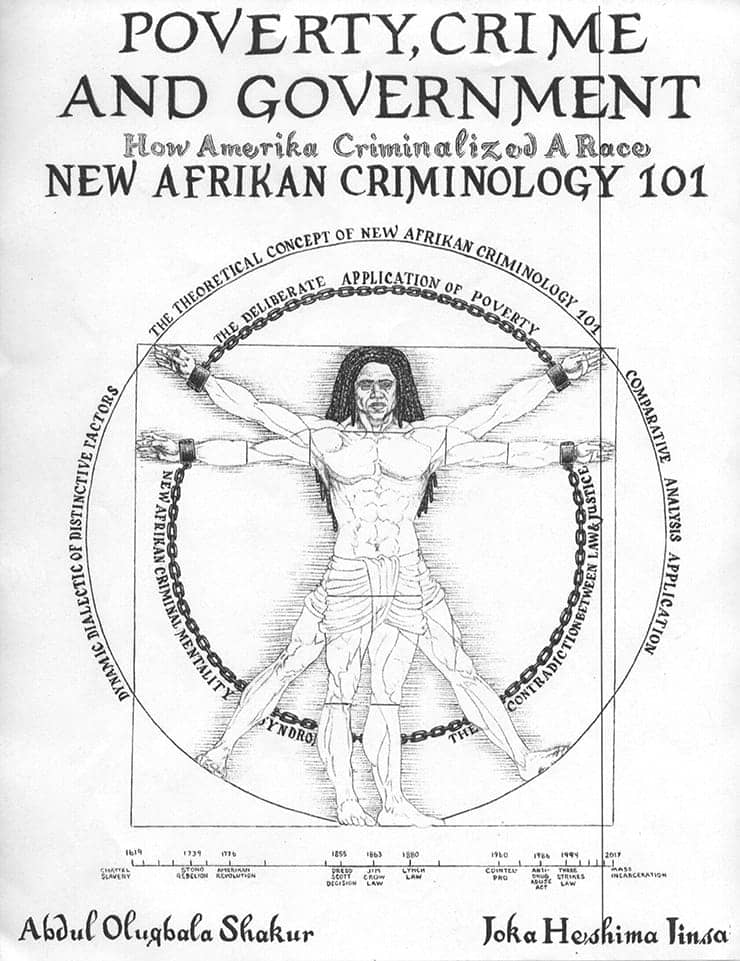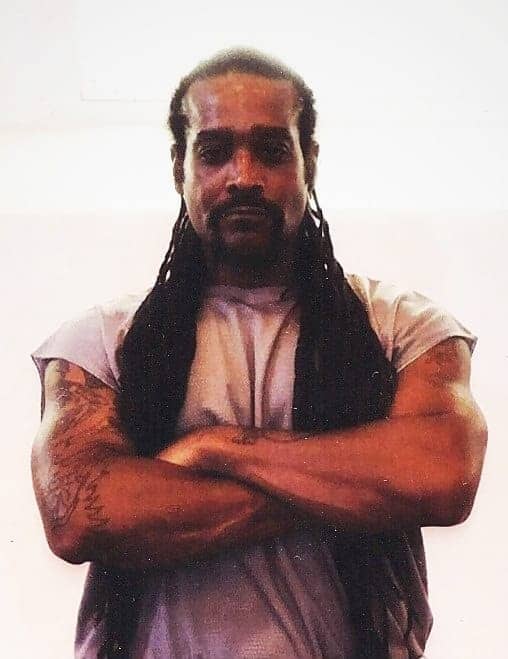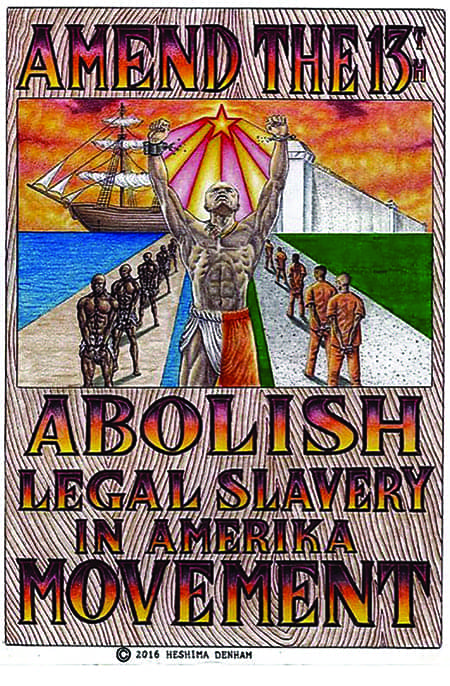by Heshima Denham of The Amend the 13th Working Group

Greetings, sisters and brothers. The general security policy of CDCr states: “The primary objectives of the Correctional institutions are to protect the public by safely keeping persons committed to the custody of the Secretary of Corrections and Rehabilitation, and to afford such persons with every reasonable opportunity and encouragement to participate in rehabilitative activities.” But what happens when state policy runs contrary to the economic and political interests of its employees, administrators and corporate stakeholders?
The recent social progress spearheaded by prisoner human rights activists in long-term solitary confinement which culminated in the Agreement to End Hostilities (AEH) and the abolition of SHU torture policies and served as the catalyst for the passage of such legislative achievements as Proposition 57 has resulted in historically low violence rates on general population facilities, unprecedented positive programming opportunities and participation, drastically reduced recidivism rates and the creation of a culture of rehabilitation among many prisoners where the talk on the yard is about getting out and staying out, as opposed to who and why “it’s on.”
This trend means the prospect of a significantly smaller prison population in the very near future and, as a result, diminished salaries and job security for CDCr employees. Understand, these seismic shifts in culture were galvanized by California prisoners, NOT CDCr employees or administrators, and this was viewed by CDCr staff and officials as a clear threat to their continued prosperity and job security, a threat to the continued success of their economic model of the Prison Industrial Slave Complex (PISC), a model based on high recidivism, institutional violence, low positive programming opportunities and failed re-entry efforts by prisoners and former prisoners.
Simply put, the high salaries and political influence of the CDCr guards’ union, administrators and their corporate partners are dependent on the criminalization and imprisonment of a significant portion of the population in New Afrikan, Latino and poor communities to maintain its appropriation of the social product, i. e., tax dollars and political influence. Prisoners’ self-actualized efforts at rehabilitation threaten this.
CDCr employees’ interests are threatened by lower violence rates in CDCr general population facilities, increased rehabilitative and reentry rates among offenders and reduced recidivism rates among former prisoners. In plain terms, CDCr’s stated aims of safely keeping persons committed to their custody and providing every reasonable opportunity for rehabilitation conflict with the functional aim of the California prison industrial slave complex: to secure lucrative and long-term job security and exorbitant salaries and policy influence in the laws which govern the social lives of citizens across the state.
To combat this threat to their labor aristocracy, CDCr secretary Scott Kernan has announced the absolutely irrational step of “non-designated facilities” across CDCr, which would in effect export reactionary gang violence now isolated on SNY facilities to general population yards across the state – a blatant gambit to plunge general population facilities back into the bad old days of reactionary violence and criminalization.

The rationale of CDCr officials is SNY facilities, in contrast to general population yards, have unprecedented levels of violence and new gangs emerging, while the informants, dropouts, pedophiles and serial rapists which make up such yards and the new gangs on them – gangs which are violently opposed to general population prisoners as the basis of the gangs themselves – would somehow be LESS violent if flooded onto general population facilities among the class of prisoners they were formed to attack. That this is an irrational contradiction is obvious.
For decades, CDCr officials maintained a domestic torture program in SHU facilities at Pelican Bay, Corcoran and Tehachapi state prisons, where, according to the same CDCr officials, “It was necessary to isolate the worst of the worst gang members, those too violent or influential to be housed in the general population, so the remainder of general population prisoners could positively program in peace without the threat of these prison gangs.” That many of these prisoners in indeterminate SHU were neither violent nor gang members, particularly in the case of New Afrikan political and politicized prisoners confined to SHU for their ideas alone, was exposed in its abolition. Yet what is relevant here is suddenly CDCr is opting to abandon this precedent in the face of historic success on general population facilities and, in the interest of both reason and public safety, we must ask ourselves why?
Why would CDCr knowingly destabilize the historic progress currently washing across general population yards by flooding them with psychologically unstable EOPs and those who openly advocate their hostility to both general population prisoners and one another, fully conscious such an action will FORCE general population prisoners to defend themselves. Why would they deliberately jeopardize the safety and rehabilitative opportunities of both SNY and general population prisoners when their stated policy is to “safely confine prisoners and provide every reasonable opportunity and encouragement to participate and rehabilitative activities?” Why would you sabotage such historic correctional success, even if it is prisoner led?
The answer is readily available in Secretary Kernan’s irrational explanation for the Department’s rationale. In both press releases and institutional videos concerning this new non-designated yard policy, CDCr officials have repeatedly made mention of the passage of Proposition 57, prisoner access to milestone completion credits and new opportunities to earn a reduced sentence as part of the catalyst for CDCr officials move to plunge prisons across California into violent conflict.
In some of the most, frankly, warped logic I’ve heard to date, CDCr official state: Prisoners released from CDCr custody back to their communities will have to function in society with formerly SNY prisoners, so if they wish to gain access to the opportunities afforded by Proposition 57 and the environment PRISONERS created for its success with the Agreement to End Hostilities, general population prisoners will now have to somehow also function IN PRISON with these SNY prisoners these same CDCr officials have deemed the most violent in the state – prisoners responsible for lying on, snitching on or preying on the families of many general population prisoners. As I’m sure any rational and reasonable person has concluded at this juncture, prison, by its very nature, precludes any socialization analogy with free society.
To be sure, following the logic of Mr. Kernan, many of the irrational restrictions in CDCr facilities, most punitive as opposed to safety and security related, should be lifted on prisoners to ensure the prison experience approximates society as closely as possible: Family visitation available to all without exception; no censorship of books, magazines and art references; free access to entrepreneurship and business opportunities for prisoners; open access to text messaging and video chatting for prisoners – ALL reasonable accommodations for the socialization of prisoners while incarcerated, NONE of them likely to materialize anytime soon because CDCr officials are adamantly opposed to them as “contrary to the nature of imprisonment and the confined status of prisoners.” Simply put, prison is NOT society.
Prisoners are classified based on multiple factors prior to their placement on a facility to ensure the safety and security of those confined to the custody of CDCr, because conditions in prison are so starkly atypical in comparison to society. Therefore, the notion that this is being done to acclimate general population prisoners to society where SNY designations DON’T exist and you are free to choose your associates and environments is an absurdity bordering on insult.
The truth of the matter is, CDCr employees and administrators are outraged at measures like Proposition 57, SB 261 and prisoner-led initiatives like the Agreement to End Hostilities because they threaten the job security, exorbitant salaries and political influence that CDCr employees have wielded with virtual impunity for the past five decades.

CDCr employees are the highest-paid prison guards in the nation, with a starting salary in excess of $70,000 a year, while the California Correctional Peace Officers Association (CCPOA) remains the most influential lobbying force in the state. With an annual operating budget over $11 billion, corporate and business interests from pharmaceutical firms to agricultural concerns to technology retailers and pay phone providers, they have generated millions of dollars in contracts, all dependent on a robust prisoner population. If current trends in rehabilitation, release and successful reentry to society continue unabated, the need for so many prisons and prison guards to staff them will simply fade away, as will the lucrative contracts to support and supply them.
To counter these legislative efforts and the Agreement to End Hostilities, CDCr plans to introduce a population of prisoners into the general population that general population prisoners will be FORCED to fight: violent SNY gangs. It will ensure a drastic uptick in violent assaults, prosecutions, lost parole dates, lockdowns (where programming opportunities are suspended indefinitely), new sentences for in custody offenses which will translate into robust prisoner population levels, job security and in some instances calls from CDCr for increased budgets to “combat this new wave of violence plaguing the department.” A wave of violence designed, orchestrated and implemented by CDCr itself.
Maintaining public safety and ensuring the safe custody of prisoners thus takes a backseat to the maintenance of job security and corporate profits in the largest conflict of interest in U.S. history: We all should be outraged that on the cusp of the success of the most unprecedented prison reform in CDCr history, that CDCr would so deliberately and completely sabotage that success – and play with the lives of tens of thousands of prisoners, their families and communities in the process.
It is incumbent upon us all to voice our outrage at this criminal gambit, no better or less repugnant than the Gladiator Games CDCr staff presided over in Corcoran SHU, only on a much larger and much more lucrative scale. Adverse public opinion is the only sure means of reversing this irrationally sadistic and greed fueled policy.
Contact your representatives, call the Office of Administrative Law and voice your opposition, post on social media and raise awareness of this evil. The collective social progress of our communities and this state hang in the balance. Join Amend the 13th in raising our voices against this evil – and together we can end it.
Send our brother some love and light: Heshima Denham, J-38283, KVSP B2-128, P.O. Box 5102, Delano, CA 93216. Heshima is the co-author of a published book and ebook: “Poverty, Crime and Government: How Amerikkka Criminalized a Race (New Afrikan Criminology 101).” For more information about the Amend the 13th Working Group, visit Amendthe13th.org.





